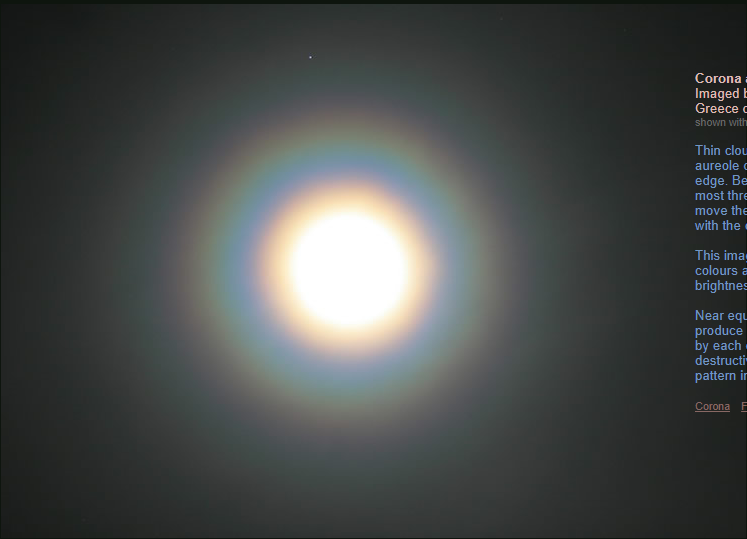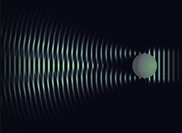Greek Corona
Greek Corona: A Spectacular Atmospheric Phenomenon
Have you ever looked up at the night sky and witnessed a mesmerizing display of light around the Moon? This enchanting phenomenon is known as the Greek Corona, named after the captivating image captured by Elias Chasiotis in Markopoulo, Greece, on March 19th, 2008. In this article, we will delve deeper into the intricacies of the Greek Corona, exploring its formation, colors, and the fascinating interplay between light and droplets.
The Greek Corona presents itself as a delicate aureole of light that encircles the Moon. This ethereal glow is typically pale red-brown or straw-colored at its edges. Beyond the aureole, you may observe one, two, or occasionally three multicolored rings. As the clouds drift across the Moon, the entire apparition fluctuates in size, mirroring the changing dimensions of the water droplets within the clouds.
To witness such a vivid corona, an essential prerequisite is the presence of cloud droplets that are roughly equal in size. These droplets act as tiny scattering agents for light waves, resulting in constructive and destructive interference patterns that produce the distinctive diffraction pattern in the sky. This intricate interplay of light and droplets gives rise to the breathtaking colors and intricate structure of the Greek Corona.
Here are some key points to consider when exploring the Greek Corona phenomenon:
-
Cloud Droplet Size: For a corona to form, it is crucial for the cloud droplets to be relatively uniform in size. This uniformity allows for consistent scattering and interference of light waves, leading to a well-defined corona with vibrant colors.
-
Constructive and Destructive Interference: When light waves pass through the cloud droplets, they undergo both constructive and destructive interference. This interference produces alternating bright and dark regions within the corona, resulting in its intricate and mesmerizing appearance.
-
Color Variations: The colors observed in the Greek Corona are a result of the wavelength-dependent scattering of light. Shorter wavelengths, such as blue and violet, tend to scatter more, while longer wavelengths, like red and orange, scatter less. This differential scattering leads to the multicolored rings observed beyond the aureole.
-
Cloud Movement: As the clouds move across the Moon, the Greek Corona undergoes dynamic changes in size and shape. These variations occur due to the varying size and distribution of water droplets within the clouds. The movement of the clouds creates an ever-shifting canvas for the corona's ethereal beauty.
-
Optimal Viewing Conditions: The best conditions for observing the Greek Corona are when thin clouds veil the Moon, allowing just enough light to pass through. This delicate balance between cloud thickness and transparency contributes to the clarity and visibility of the corona.
-
Photographic Opportunities: Capturing the Greek Corona in all its glory requires both skill and timing. Photographers, like Elias Chasiotis, have managed to immortalize this captivating phenomenon, showcasing its colors, delicacy, and relative brightness through their lens.
The Greek Corona is a testament to the enchanting interplay between light and atmospheric phenomena. Its ephemeral beauty serves as a reminder of the intricate wonders that can be found in our natural world. So, the next time you gaze at the Moon on a cloudy night, keep an eye out for this captivating spectacle unfolding above you.

Corona around the Moon
Imaged by Elias Chasiotis at Markopoulo, Greece on 19th March 2008. ©Elias Chasiotis, shown with permission.
Thin clouds veil a moon surrounded by a pale aureole of light red-brown/straw coloured at its edge. Beyond the aureole are one, two or at most three multicoloured rings. As the clouds move the whole apparition shrinks and grows with the changing size of their water droplets.
This image shows the corona perfectly, its colours and the delicacy and relative brightness of the rings.
Near equal sized cloud droplets are needed to produce such a corona. Light waves scattered by each droplet interfere constructively and destructively to produce the large diffraction pattern in the sky.
Corona Formation Droplets & light

Note: this article has been automatically converted from the old site and may not appear as intended. You can find the original article here.
Reference Atmospheric Optics
If you use any of the definitions, information, or data presented on Atmospheric Optics, please copy the link or reference below to properly credit us as the reference source. Thank you!
-
<a href="https://atoptics.co.uk/blog/greek-corona/">Greek Corona</a>
-
"Greek Corona". Atmospheric Optics. Accessed on April 19, 2024. https://atoptics.co.uk/blog/greek-corona/.
-
"Greek Corona". Atmospheric Optics, https://atoptics.co.uk/blog/greek-corona/. Accessed 19 April, 2024
-
Greek Corona. Atmospheric Optics. Retrieved from https://atoptics.co.uk/blog/greek-corona/.